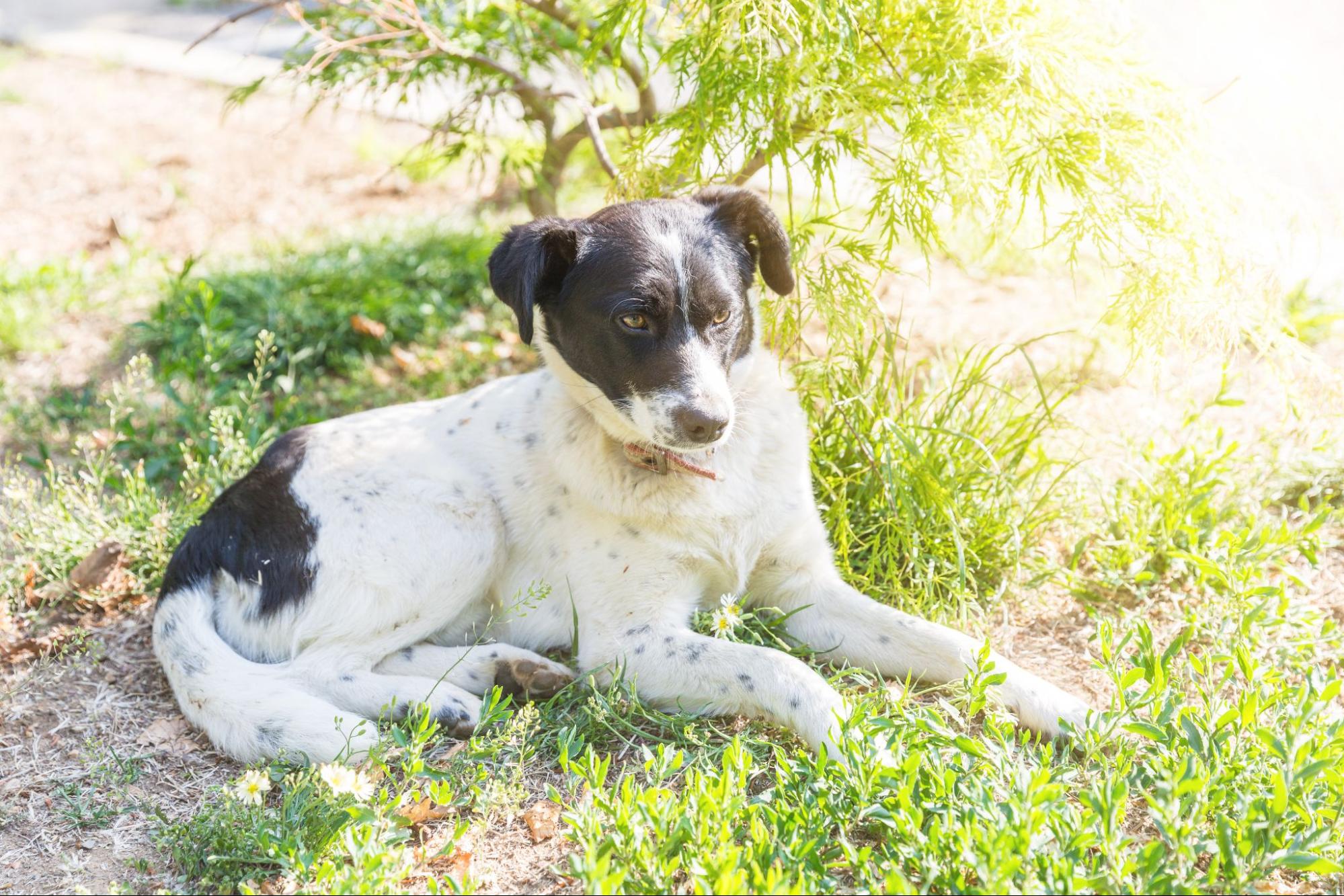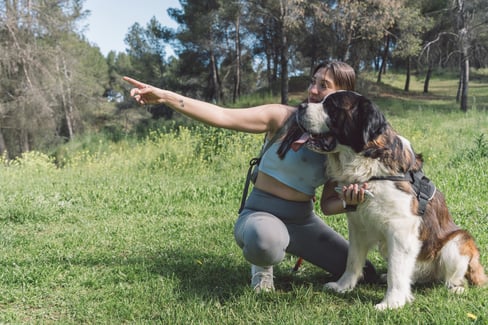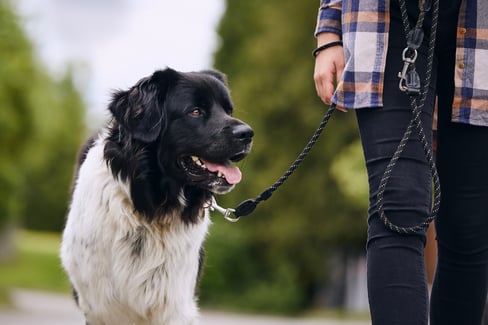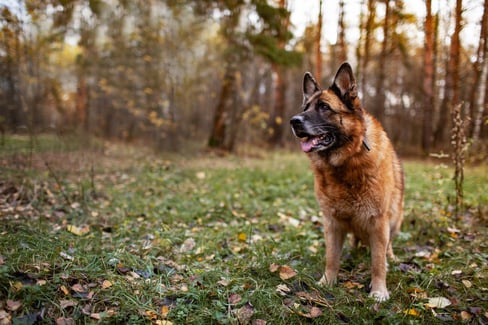Table of Contents
Just like humans, dogs can sometimes suffer from hip dislocation (also called hip luxation). It’s a serious injury that requires immediate veterinary care.
The hip is a ball and socket joint that allows your dog to move their hind limbs in various directions. The top of your dog’s femur (ball) fits into a part of the hip called the acetabulum, a cup-shaped depression in the pelvic bone (socket).
The stability of the dog’s hip joint depends on how well the femoral head and acetabulum fit together, as well as the round ligament (also known as the teres ligament) which connects the femoral head to the acetabulum and is protected by a fibrous joint capsule. Of course, there are also muscles surrounding these structures that aid in stability.
Reading about these connections that make up your dog’s hip bone might have conjured up memories of singing Dem Bones as a child.
But it’s important information to know, especially given that conditions that contribute to the potential of dog hip joint dislocation are relatively common:
- One study on hip dysplasia in dogs puts the prevalence at just over 15%, with some breeds, like golden retrievers, having a higher risk at 20%.
- Another study conducted by the Orthopedic Foundation of Animals (OFA) from 1974 to 2010 found that hip dysplasia in large-breed dogs is more prevalent compared to small-breed dogs.
Usually, a dog with a dislocated hip is the most common after sudden, severe trauma, such as getting hit by a car, but dog hip dysplasia can make it easier for the hip joint to fall out of place, meaning that less severe trauma like landing from a short fall can cause the ball joint to come out of place.
Even so, a dog with dislocated hip may not be the easiest to recognize in all cases, so learning the signs of dog hip dislocation can help get your dog treatment faster. In addition, if a sudden hip dislocation happens to your pup, it helps to gain insight into the typical process of vet care and home treatment.
Signs of Dog Hip Dislocation
Typical signs that a dog may have hip dislocation include:
- Severe lameness in one or more hind limbs
- Holding the affected limb close to the body in a folded position
- The affected limb and the hip area may be hot to the touch (an indication of inflammation)
- The affected limb and hip area may appear swollen
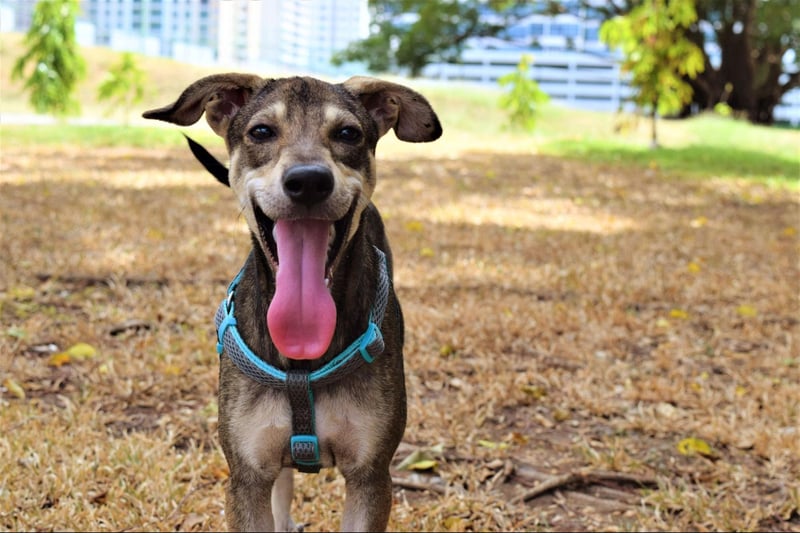
In addition to these signs, it is also important to recognize potential symptoms that your dog might have a dislocated hip, especially if they have a condition like hip dysplasia or degenerative joint disease (DJD) that make it easier for a hip dislocation to happen.
Hip Dislocation Dog Symptoms
The difference between signs and symptoms is important because they are often used simultaneously. Signs are visual indicators that something is wrong with your dog, like swelling or redness, while symptoms represent what your dog is feeling, like pain and lethargy.
It’s important to recognize signs and symptoms because not all dogs will exhibit both. Dogs will instinctively try their best not to show that they are in pain or feeling off. In the wild, a sick or injured dog is a liability to the rest of the pack and would typically be abandoned. So your dog is trying to protect themself by acting as normal as possible.
At the same time, it can be difficult to keep a straight face when you’re in severe pain. But it’s important to be able to recognize a combination of signs and symptoms that your dog may exhibit so you can put the pieces together and realize that your dog may be experiencing a severe issue.
With that being said, here are some hip dislocation dog symptoms that are important to know:
- Uncharacteristic aggressive behaviour, including growling and biting, especially when you try to get close to the affected limb
- Signs of lethargy and disinterest in normally exciting activities
- Reluctance to eat and drink
- Hiding and withdrawing
What Does a Dislocated Hip Look Like on a Dog
A dog with dislocated hip will usually stand with the affected leg up, either tucked up against their body or with their foot slightly off the ground. The affected leg may appear shorter than the other three because of the contracting ligaments and muscles.
A radiograph (x-ray) conducted by a veterinarian is necessary to confirm the luxation. There are two types of hip dislocation, full and partial. With full dislocation, the femoral head will have completely left the hip socket, so you might see a bump in your dog’s hip area where the femoral head has ended up. For a partial dislocation, the femoral head will not completely leave the hip socket but rather be out of place.
Can a Dog Walk With a Dislocated Hip?
A dog with dislocated hip will have severe hind limb lameness and will likely not be able to put any weight on the affected limb. Instead, the dog will carry the leg in a flexed position (folded or pulled up), with the foot rotated slightly outwards. In this position, the limb may appear to be shorter compared to the dog’s other limbs. Your dog may still be able to walk on their remaining three limbs, but the effort required to move and the pain associated with the dog joint hip dislocation will likely mean that your dog will prefer to lie down.
If the hip is luxated rather than completely dislocated, your dog may have a slightly easier time moving around since the joint isn’t completely out of the socket, but the pain and stiffness will likely mean that they won’t want to move around for long without resting.

Challenges of Dog Hip Joint Dislocation
A dog with dislocated hip isn’t always the easiest to fix. Sometimes the luxation can be fixed with non-invasive measures like using a dog hip support harness or sling, but sometimes surgery is necessary.
One of the biggest challenges of treating a dog with dislocated hip is time. If the injury is left too long, your dog’s body will try to stabilize the area with scar tissue, which is not a very strong or effective solution, as it can easily tear and will not give your dog full range of motion. Plus, the bones are more likely to rub on each other, causing severe pain.
The more time that passes between the injury and treatment, the more difficult it is for the veterinarian to perform dislocated hip dog treatment because the muscles and ligaments will atrophy and be difficult to manipulate, and scar tissue will get in the way.
With that being said, the two types of intervention that a veterinarian will use to correct a dog with dislocated hip are outlined in the table below:
|
Type of Dog Dislocated Hip Treatment |
Description |
|
Closed Reduction |
The name of a non-invasive procedure that is sometimes used by veterinarians to put the luxated hip joint back into place. |
|
Surgery |
|
Challenges with Closed Reduction Dog Dislocated Hip Treatment
If the hip appears to be normal aside from the luxation (no signs of hip dysplasia or DJD) then it’s likely that the veterinarian will try a closed reduction treatment method to fix the problem first.
But if the dog owner hasn’t brought their dog in within three days of the hip dislocation occurring, then the resulting muscle contraction makes a successful reduction very difficult to perform. It is especially difficult to manipulate the hip joint back into place with large dogs. In addition, the dog must be anesthetized to relax the local muscles, which always poses a risk to the dog, especially if it is a small dog (the smaller the animal, the more precise that anesthesia needs to be).
After the femoral head is put back into its correct position, the dog must be confined for at least two weeks in a small area so that the joint tissue can heal. During the healing period, an Ehmer sling is sometimes used to hold the leg in place. However, slings can be difficult to apply, and if they are not perfectly fitted, sores can develop on the dog’s leg. For these reasons, some veterinarians will instruct cage rest over a sling.
With closed reduction, there is a high chance that the hip joint will dislocate again, resulting in needing surgery anyway.
Challenges with Surgery for Dog Dislocated Hip Treatment
There are several surgical techniques that can be used to correct a dislocated hip in a dog. Your veterinarian will be able to determine which type of surgery is needed based on the severity of the injury and your dog’s conformation.
For any dog dislocated hip surgery, bandaging is necessary, and the dog will need to be confined for at least two weeks to heal. Challenges with any of the hip dislocation correction surgeries include the risks associated with anesthesia, and the possibility that any movement could cause the hip to once again luxate. However, despite these challenges, surgical treatment for a dog with dislocated hip has a significantly higher success rate than a closed reduction.
FHO is a very common option for treatment because when it comes to dog hip dislocation surgery cost, an FHO is the least expensive option. It is best used for smaller dogs that are less than 50 lbs. In this surgery, the femoral head is completely cut off, which allows the joint to heal as a “false joint”. In other words, a new capsule will form that connects the femur to the hip bone without the two bones touching each other. But if the dog is too heavy, then the false joint won’t be strong enough to sustain their weight.
For a false joint to form, the dog should be active. Usually, a dog will not want to use the leg too much for the first couple of weeks, but their confidence in using the leg should increase between weeks 4–6. After a few months, the dog should walk normally with their new joint.
Unfortunately, although FHO can be successful for some dogs, there is still a risk that the dog will be left with chronic pain and lameness.
Regardless of the treatment that your dog receives to correct a dislocated hip, it’s always a good idea to start giving them joint supplements immediately. A supplement like TRI-ACTA H.A., which contains two types of glucosamine for dogs (cartilage repair and general joint health), chondroitin (works together with glucosamine for cartilage repair and regeneration), Methylsulfonylmethane (MSM, a natural anti-inflammatory) and hyaluronic acid (improves viscosity of joint fluid) is a great choice as it includes 100% active ingredients with no fillers or additives.
What to Do When Your Dog Has a Dislocated Hip
First and foremost, if you suspect your dog has a dislocated hip, you should immediately bring them to a veterinarian. This may mean that you have to seek out emergency veterinary care depending on the time of day that the injury happens.
You will want to gently lift your dog into a vehicle to transport them to the vet. If you have a heavy dog, getting assistance from another person to help you lift them carefully is recommended. While hip dislocation is different from other conditions like arthritis, lifting your dog by tucking your arms under your dog’s body and lifting the rear and front ends at the same time can help reduce pressure on your dog’s affected limb or limbs.
Dog Dislocated Hip Treatment
Treatment for a dog with dislocated hip will require a veterinarian to either perform a closed reduction procedure to put your dog’s joint back in place or surgical intervention. This section breaks down some more specific details regarding the costs and healing time involved with dog hip dislocation correction procedures and outlines some tips that you can use to make taking care of your dog at home easier.
1. Vet Care
The first thing that your veterinarian will do is perform a radiograph (x-ray) to determine the extent of the hip dislocation injury and help them brainstorm possible treatment options.
It’s difficult to give an exact number in terms of dog hip dislocation cost, as every vet clinic will charge different amounts, but the table below provides some general ranges:
|
Treatment Type |
Estimated Cost Range (CAD) |
|
Closed Reduction |
Between $1,200–$2,500 |
|
General Hip Repair Surgery |
Between $3,000–$5,000+ |
|
Femoral Head Osteotomy |
Between $1,200–$2,500 per hip |
|
Total Hip Replacement |
Between $3,500–$7,000 per hip |
As you can see, dog hip dislocation surgery cost varies greatly depending on the procedure and the vet clinic themselves. Some vet clinics may offer financing options or payment plans. It’s best to contact your vet and get a breakdown of the costs that will be required for your dog’s hip dislocation treatment.
2. At Home Care
After your dog receives treatment for their dislocated hip, your veterinarian will likely prescribe NSAIDs (non-steroidal anti-inflammatory drugs) to help control the pain. In addition, your vet will likely recommend that your dog stay confined to a crate or small area to discourage them from moving around and aggravating the injury as it tries to heal.
In terms of medical equipment, your dog will likely need to wear an Elizabethan collar (cone) for at least a week to prevent them from licking and biting the surgical site. If your vet bandaged the area, they will likely instruct you to check the bandages after the first day or two for any signs of discharge or continued swelling that could indicate an infection.
After the first two weeks, your vet may also give you instructions on a few rehabilitation exercises you can do with your pup to help them regain range of motion. Be sure to follow these instructions carefully so as to not overexert your dog’s hip joint and cause pain or increase healing time.
Prevention of a Dislocated Dog Hip
Taking care of a dog with a dislocated hip can be a difficult and long process as they heal. Some dogs are predisposed to joint problems like hip dysplasia, which can significantly increase the risk of them having to deal with hip dislocation, while other dogs may experience it from general joint degradation or from a traumatic injury.
While we can’t always prevent accidents, there is a way that you can help reduce your dog’s chances of having to deal with a dislocated hip—by strengthening your dog’s joint health, including their hips, with a joint supplement for dogs.
Integricare offers two formulations of joint supplements: TRI-ACTA and TRI-ACTA H.A. Here are the differences between the two:
- TRI-ACTA is a general, preventative joint supplement that can be given to all dogs, even puppies, that don’t currently have joint problems. Unlike most joint supplements on the market, TRI-ACTA contains two types of glucosamine (Sulfate and HCl), which ensure that your dog gets the maximum joint support possible. Glucosamine sulfate provides sulfur to your dog’s joints, essential for overall joint health and stability. Glucosamine HCl is a highly bioavailable form of glucosamine, meaning your dog’s body will be able to use it faster. The two types of glucosamine are combined with chondroitin (works with glucosamine to repair cartilage) and MSM, a natural anti-inflammatory to keep your dog moving freely and without pain.
- TRI-ACTA H.A. Has all the same ingredients as TRI-ACTA but includes the extra healing power of hyaluronic acid, which increases the viscosity of the synovial (joint) fluid to provide easier and more pain-free movement. TRI-ACTA H.A. is recommended for dogs with existing joint issues.
Additional Senior Dog Hip Support
There are various other supports that you can provide to your dog with hip issues to help prevent hip dislocation and to support their overall hip health.
1. Dog Hip Support Harness
The dog hip support harness is a lifting aid that supports your dog’s hind quarters either by you physically keeping your dog’s hips upright, or by attaching to a dog wheelchair. In both cases, the harness can be used temporarily to assist your dog with performing daily activities like walks, trips to the dog park, and more.
2. Dog Hip Support Brace
A hip support brace can be used to provide comfort and support for dogs that suffer from hip dysplasia or are recovering from hip surgery or a procedure like closed reduction. The brace helps keep the hip bones in place as your pup moves and also provides some compression around your dog’s hip joint to aid in swelling reduction and to promote healing.
3. Dog Dislocated Hip Sling
A hip sling is often used directly after surgery or a hip-related treatment to keep the joint structures in place as they heal. The sling completely restricts the movement of the hip joint but can potentially slide and move, resulting in sores forming under the sling. For this reason, some specialists recommend against using a dog dislocated hip sling and instead advise to keep the dog in a confined area as they heal.
Conclusion
Dealing with a dislocated hip in dogs is a challenging and complex process that requires immediate veterinary attention. Understanding the signs and symptoms, along with the available treatment options, is crucial for pet owners. Hip dislocations can result from various factors, including trauma and underlying conditions like hip dysplasia. Prompt diagnosis and appropriate intervention are essential to prevent complications and chronic pain for the affected dogs.
Additionally, preventive measures, such as joint supplements and supportive devices like harnesses and braces, as well as joint supplements, can contribute to strengthening a dog's overall hip health and reducing the risk of hip dislocations.
Purchase TRI-ACTA online today or learn where to buy at a store near you.
Newsletter Signup
Subscribe to our newsletter to receive the latest news and exclusive offers.
.jpg?height=2000&name=Cliick_Integricare-DISPLAY-REVISEDV2%20(1).jpg)
Proactive & Therapeutic Joint Supplements
When given daily, Integricare joint supplements recover bone and joint injuries faster and help prevent mobility injuries from happening in the first place.

